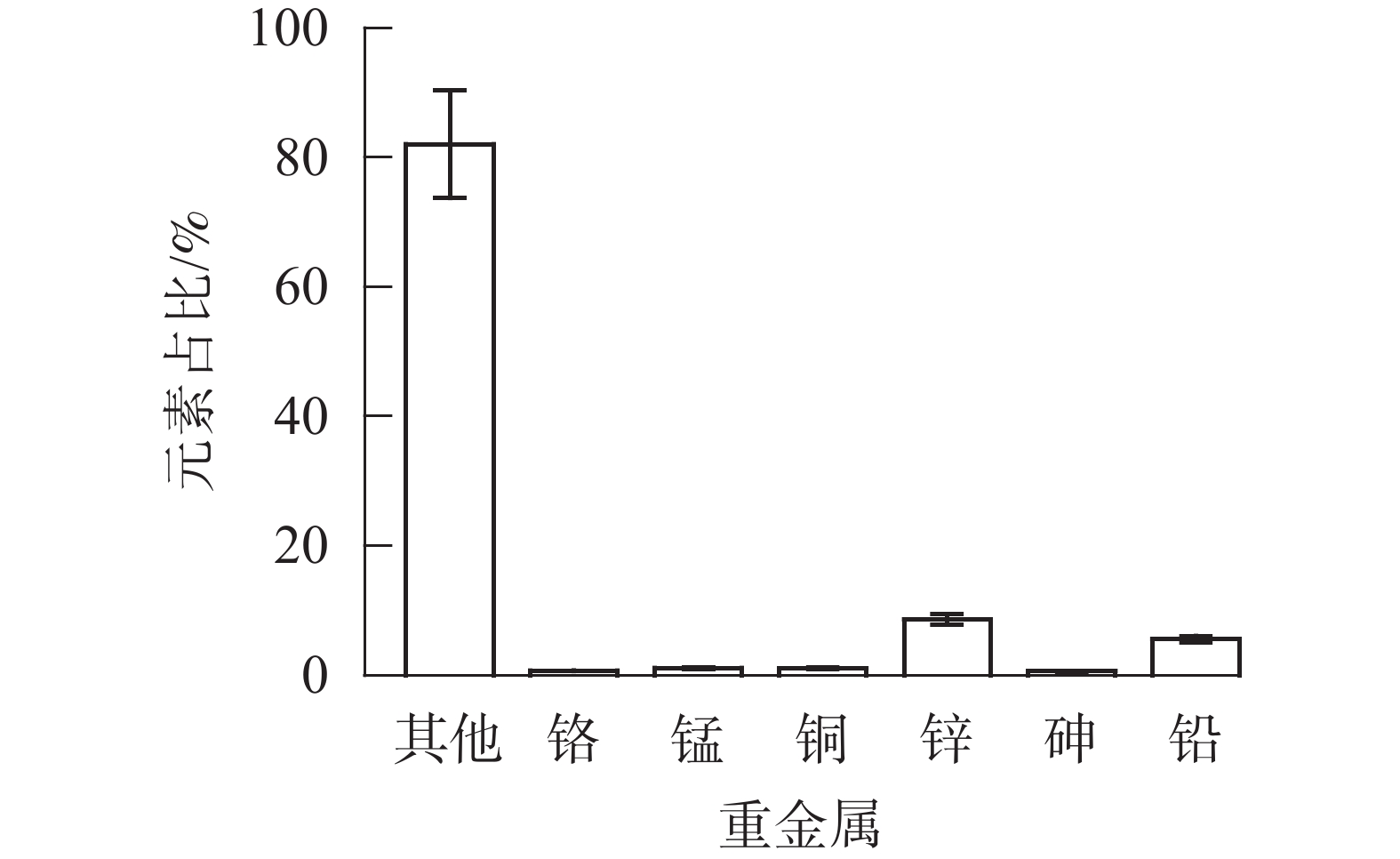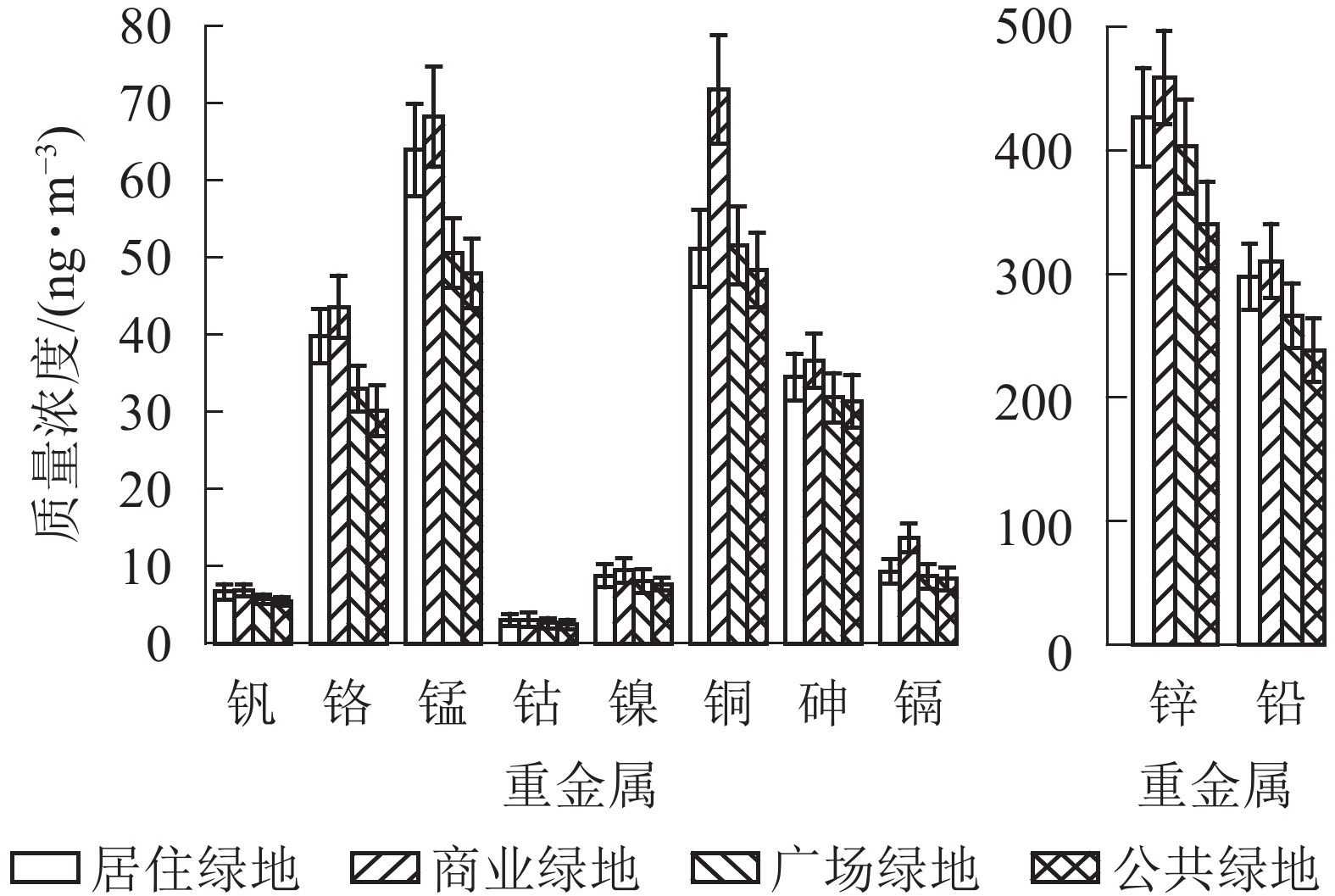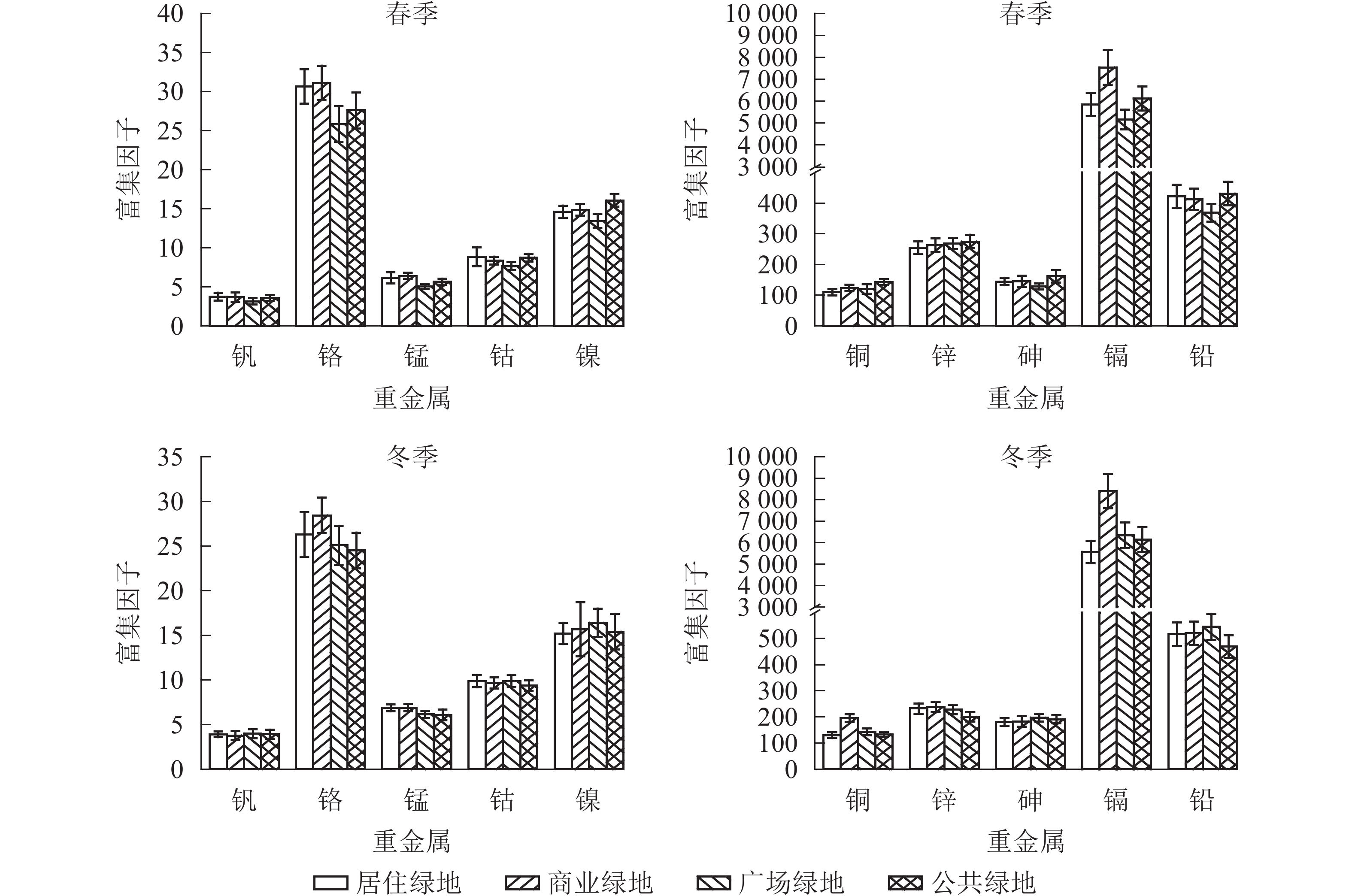-
随着城镇化进程加快,以细颗粒物(PM2.5)为首的大气颗粒物污染越来越严重。大气环境的质量评价和污染防治已成为大气污染研究领域的主要方向之一[1-2]。PM2.5会通过呼吸进入肺部,其粒径小[3]、比表面积大[4],同时携带大量重金属元素和其他有毒物质[5-7]。长期生活在严重污染的大气环境下,人们患心血管、呼吸系统等疾病的风险明显增加[8-9],身体健康受到严重危害[10]。研究表明:铬、钴、镍和砷等易引发细胞癌变[11];过量的锌则会引发贫血和食欲下降[12];镉容易造成细胞癌变和骨质疏松[13];铅对儿童和妊娠妇女的影响极大[14]。绿地在生态系统中具有自净功能,在调节生态平衡、改善环境质量和保护人体健康等方面发挥着积极作用[15]。目前,有关城市绿地与大气颗粒物关系的研究集中在2个方面:一是植物枝干和叶片的滞尘效应[16]。如李超群等[17]研究表明:5种地被植物叶片的滞尘量与叶表面微观结构有关,被毛或边缘有齿的叶片滞尘效果较好。二是植物群落对大气颗粒物的消减作用[18]。如刘宇等[19]发现:江苏省宿迁市不同植物群落类型绿地内PM2.5浓度由大到小依次为草坪、篱草、大阔叶乔草、乔灌草、针叶乔草和小阔叶乔草。近年来,有学者采用ArcGIS对大气中重金属元素含量进行空间分析,发现铜、锌和镉的空间分布特征较为相似,高值出现在车流量大的区域[20]。于瑞莲等[21]分析了福建省泉州市不同功能区大气降尘中重金属含量,发现重金属的生态危害程度从大到小依次为工业区、商业区、交通区、居民区、农业区。以上研究大多集中在城市功能区,而公园绿地、附属绿地等城市绿地内的重金属分布及污染研究鲜有报道。本研究选取杭州市临安区4种城市绿地作为研究对象,分析绿地内PM2.5中重金属的时空变化规律及其影响因素,探究重金属来源,为城市绿地的科学规划和大气污染防治提供参考。
HTML
-
杭州市临安区地处浙西中低山丘陵区,呈东西狭长形地貌,境内多高山[22]。属季风型气候,四季分明,温暖湿润,光照充足,雨量充沛。年平均气温16.4 ℃,年平均日照时数1 837.9 h,年平均降水量1 613.9 mm。植被类型为亚热带常绿阔叶林,素有“大树华盖闻九州”之誉的天目山位于临安境内。近年来,随着工业、运输业的快速发展,大气污染问题愈发突出[23-24]。
根据CJJ/T 85−2017《城市绿地分类标准》[25],选取居住绿地、商业绿地、广场绿地和公共绿地等4种绿地作为研究对象,分别位于春天小区、衣锦商业街、五舟广场和浙江农林大学东湖校区。居住绿地、商业绿地和公共绿地植物配植均为乔木-灌木-地被3层结构,其植物种类、郁闭度、种植密度及成熟度等群落结构特征基本一致。春天小区坐落在玲珑山脚,小区四周被城市主干道围合,交通便捷,有3个出入口,绿地率为42.5%。样地位于小区的3号楼与4号楼之间,四周均由高层建筑围合,私密性高,面积约1 500 m2。乔木层植物主要有杜英Elaeocarpus decipiens、乐昌含笑Michelia chapensis、桂花Osmanthus fragrans,灌木层植物有海桐Pittosporum tobira、红花檵木Loropetalum chinense var. rubrum,地被植物有麦冬Ophiopogon japonicus等。衣锦商业街位于临安区中心位置,是重要的商业街区之一,人流及车流量大。样地选择在紧邻浙江农林大学衣锦校区南门处的公共区域,面积约1 800 m2。乔木层植物主要为樟树Cinnamomum camphora、紫楠Phoebe sheareri、荷花玉兰Magnolia grandiflora,灌木层有石楠Photinia serrulata、荚蒾Viburnum dilatatum,地被植物为麦冬。五舟广场位于临安区东北部,是重要的市民活动广场,日常人流量较大。广场以硬质铺装为主,少量点缀紫薇Lagerstroemia indica和杨梅Myrica rubra,四周空旷,总面积约4 500 m2。公共绿地选择在浙江农林大学东湖校区的学院楼4号楼南侧,为师生活动、交流空间,面积约1 600 m2。乔木层植物主要有冬青Ilex chinensis、玉兰Magnolia denudate、鹅掌楸Liriodendron chinense,灌木层为山茶Camellia japonica,地被植物为麦冬。
-
在4个绿地的近中心位置,距离地面1.5 m处各布置1台智能中流量TSP采样器(KC-120H),并安装QMA石英纤维滤纸同步采集空气中的PM2.5。因持续低温、降雪及梅雨季降雨等影响,采样时间选择2017年3月、4月(春季)和2月、12月(冬季),每月分别于月初、月中和月末各1 d采样。每天连续采样8.5 h(8:00−16:30)。要求试验前1周内无降雨、大风等情况发生,采样当天天气晴朗、无风或微风。采样前用锡箔纸包裹滤纸,置于马弗炉(设定温度450 ℃)中灼烧4 h,除去滤纸上原有的有机物及杂质,之后将滤纸静置于恒温恒湿箱(Premium ICH,设定温度25 ℃、相对湿度50%)内48 h。取出后使用电子天平(SI-234,精度0.1 mg)称量和记录滤纸质量,重复称量3次,取平均值作为滤纸采样前的质量。采样完成后将滤纸再次在恒温恒湿条件下处理并称量,记录滤纸质量,方法及步骤同采样前。滤纸前后称得差值即为该时段内采集的PM2.5质量。将采样后的滤纸放置在特氟隆容器中,依次加入去离子水、浓硝酸、氢氟酸和高氯酸消解。通过电感耦合等离子体质谱仪(Elan 9000)检测滤纸上镁、铝、钾、钙、钛、钒、铬、锰、铁、钴、镍、铜、锌、砷、镉、锑和铅等17种元素及各元素质量浓度。为确保试验结果的有效性,同步检测空白滤纸上的元素,结果表明空白滤纸上的各元素质量浓度均低于检出限值,因此检测结果有效。
-
富集因子(enrichment factor,FE)是用以定量评价污染程度与污染来源的重要指标,以满足一定条件的元素作为参考元素,以样品中污染元素质量分数与参考元素质量分数的比值与背景区中两者质量分数的比率[26]来表示。公式为:
其中:Ci和CR分别表示污染元素i和参考元素R的质量浓度。铝是常用的参考元素,杭州市锰、锌、钡、铬、铅、镍、铜、钴、砷和镉的土壤背景值分别为346.00、62.10、62.00、49.70、22.40、20.90、15.00、11.60、7.50和0.06 mg·kg−1。当富集因子值小于10,表明元素是非富集的,主要为自然污染;当富集因子值大于10,表明元素已富集,主要为人为污染。
主成分分析是通过正交变换将一组可能存在相关性的变量转换为一组线性不相关的变量,转换后的这组变量叫主成分[27]。大气污染物来源广泛,通常多种污染源会存在一定的相关性,找出有一定相关性的污染物重新组合成一个新成分,在此基础上用Spearman相关系数分析污染源的相关性,可以进一步明确污染物的来源。
-
采用Excel 2010统计和整理数据、SPSS 22.0进行Spearman相关性分析、Origin 8.0作图。
1.1. 研究对象
1.2. 数据获取
1.3. 分析方法
1.4. 数据处理
-
由图1可知:4种绿地内PM2.5质量浓度冬季平均值为(102.68±9.43) μg·m−3,春季为(48.34±5.13) μg·m−3。2个季节PM2.5质量浓度均超过GB 3095−2012《环境空气质量标准》[28]规定的二级质量浓度限值(35 μg·m−3)和欧洲空气质量准则[29]规定的质量浓度日均值(25 μg·m−3)。在空间上,位于城市道路旁边的商业绿地,春、冬季PM2.5质量浓度平均值最高,为(84.12±6.15) μg·m−3,居住绿地[(76.41±7.30) μg·m−3]和广场绿地[(75.55±8.20) μg·m−3]次之,公共绿地[(65.98±7.40) μg·m−3]最低。
-
春、冬季不同绿地内PM2.5中铬、锰、铜、锌、砷和铅等6种重金属平均质量浓度占所测元素总质量浓度的17.95%,而钒、钴、镍和镉等4种重金属仅占0.56%。10种重金属平均质量浓度为(2.83±0.52)~(429.69±22.59) ng·m−3,其中:锌和铅较高,分别为(429.69±22.59)和(278.23±18.29) ng·m−3,分别占元素总质量浓度的8.65%和5.60%;钒和钴较低,仅为(6.22±0.59)和(2.83±0.52) ng·m−3,分别占元素总质量浓度的0.13%和0.06%(图2和图3)。
由图4可知:4种绿地内重金属总质量浓度平均值不同,冬季为(950.13±90.15) ng·m−3,春季为(843.55±80.70) ng·m−3。春季不同重金属质量浓度为(2.10±0.60)~(459.30±43.00) ng·m−3,商业绿地内锌和铅较高,分别为(459.30±43.00)和(259.70±23.00) ng·m−3,公共绿地内钴最低,仅为(2.10±0.60) ng·m−3;冬季不同重金属质量浓度为(2.85±0.80)~(458.98±40.00) ng·m−3,与春季相似,商业绿地内锌[(458.98±40.00) ng·m−3]和铅[(361.30±35.00) ng·m−3]较高,公共绿地内钴[(2.85±0.80) ng·m−3]最低。4种绿地内,钒、锰、钴、镍、铜、砷、镉和铅的质量浓度均表现为冬季大于春季,与PM2.5质量浓度的季节变化趋势一致,锰、铜、砷和铅季节差异显著(P<0.05),钒、钴、镍和镉的季节差异不显著(P>0.05)。此外,铬和锌的质量浓度季节差异亦不显著(P>0.05)。
在空间上,春、冬季重金属总质量浓度平均值从大到小依次为商业绿地[(1 023.18±94.10) ng·m−3]、居住绿地[(942.20±89.20) ng·m−3]、广场绿地[(861.85±84.05) ng·m−3]、公共绿地[(760.18±80.48) ng·m−3]。10种重金属质量浓度最高值均出现在商业绿地内,最低值均在公共绿地内,其中:锌最高,为(459.14±38.00) ng·m−3;钴最低,仅为(2.48±0.60) ng·m−3。另外,居住绿地和广场绿地内锌质量浓度均最高,分别为(426.94±40.00)和(403.00±38.00) ng·m−3;钴均最低,分别为(3.07±0.80)和(2.65±0.65) ng·m−3;重金属质量浓度从大到小依次均为锌、铅、锰、铬、砷、镉、镍、钒、钴(除铜以外,图5)。
-
富集因子值反映了重金属元素在大气颗粒物中的富集程度,可分析自然来源和人为来源对大气污染的相对贡献[26]。如图6所示:春、冬季绿地内重金属元素的富集因子平均值从大到小依次为镉、铅、锌、砷、铜、铬、镍、钴、锰、钒。由于天气条件和污染排放源不同,钒、锰、钴、镍、铜、砷、镉和铅的富集因子值均呈现为冬季大于春季。钒、锰和钴的富集因子值小于10,表明这3种元素来自自然污染;铬、镍、铜、锌、砷、镉和铅大于10,表明这7种元素来自人为污染。
采用主成分分析法进一步明确绿地内PM2.5中重金属的来源,结果见表1和表2。由表1可知:主成分1的贡献率达63.43%,载荷较高的为铬、锰、铜和锌。研究认为:铬是钢铁冶炼的标志性元素[30],锰为地壳源,铜和锌主要来自机动车尾气排放和轮胎磨损[6, 31]。绿地内铬的富集因子值为24.51~31.10,且与锰、铜和锌呈极显著相关(P<0.01,表2)。主成分1是自然源、道路扬尘、机动车尾气和工业排放组成的复合源。主成分2的贡献率为13.17%,载荷较高的为钒、砷、镉和铅。钒的富集因子值小于10,表明其为自然源,镉与电镀镀种和工艺有很大关系[32],砷和铅为燃煤排放。同时,铅是机动车尾气排放的标志性元素[33]。随着中国全面进入无铅化汽油时代,机动车尾气排放已不再是铅的主要来源[34],因此,砷和铅主要来自燃煤污染,工业排放对主成分2的贡献较大。主成分3的贡献率为8.30%,载荷较高的为镍和锌,镍和锌主要来自机动车尾气和燃油[35],所以主成分3为交通污染源。综上所述,绿地内钒为自然源;铬、锰、铜和锌为自然源、道路扬尘、机动车尾气和工业排放的复合源;砷、镉和铅来自工业源;镍和锌为交通源。
元素 旋转后主成分因子载荷 元素 旋转后主成分因子载荷 主成分1 主成分2 主成分3 主成分1 主成分2 主成分3 钒 0.193 0.821 0.142 锌 0.873 0.267 0.804 铬 0.915 0.197 0.110 砷 0.478 0.669 0.322 锰 0.711 0.503 0.305 镉 0.271 0.762 −0.507 钴 0.581 0.507 0.512 铅 0.445 0.732 0.414 镍 0.272 0.130 0.896 贡献率/% 63.430 13.170 8.300 铜 0.798 0.327 0.294 累积贡献率/% 63.430 76.600 84.900 Table 1. Factor loading of heavy metals in PM2.5 in the first three principal components
钒 铬 锰 钴 镍 铜 锌 砷 镉 铅 钒 1 铬 0.400** 1 锰 0.593** 0.795** 1 钴 0.601** 0.718** 0.769** 1 镍 0.328* 0.366* 0.507** 0.647** 1 铜 0.434** 0.758** 0.795** 0.700** 0.546** 1 锌 0.481** 0.791** 0.726** 0.706** 0.379** 0.777** 1 砷 0.515** 0.602** 0.780** 0.751** 0.431** 0.699** 0.550** 1 镉 0.551** 0.326* 0.390** 0.278 0.206 0.350* 0.391** 0.455** 1 铅 0.625** 0.562** 0.812** 0.841** 0.533** 0.736** 0.594** 0.907** 0.463** 1 说明:**表示在0.01水平(双侧)上极显著相关;*表示在0.05水平(双侧)上显著相关 Table 2. Correlation analysis of heavy metals in PM2.5 in green spaces
2.1. 绿地内PM2.5质量浓度变化
2.2. 绿地内PM2.5中重金属质量浓度变化
2.3. 绿地内PM2.5中重金属来源
-
4种绿地内重金属总质量浓度平均值与PM2.5质量浓度的季节变化趋势一致,均表现为冬季大于春季。临安地区冬季寒冷,近地层大气稳定,远距离输送的污染物不易扩散,加之植物进入休眠期,滞尘能力下降,因此冬季大气污染较重。春季,随着天气回暖,植物生长迅速,对颗粒物的滞留和吸附能力增强,这对改善空气质量起到积极作用。研究[36]表明:PM2.5质量浓度日变化呈现“早晚高、中午低”的现象,峰值出现在8:00和18:00。绿地内钒、锰、钴、镍、铜、砷、镉和铅的质量浓度均为冬季大于春季,铬和锌的季节差异不显著。雷文凯等[37]研究表明:保定市PM2.5及其重金属质量浓度为秋冬季大于春夏季,这与本研究结果一致。在空间上,由于机动车尾气排放和其他人为活动的影响,春、冬季重金属总质量浓度平均值从大到小为商业绿地[(1 023.18±94.10) ng·m−3]、居住绿地[(942.20±89.20) ng·m−3]、广场绿地[(861.85±84.05 ng·m−3]、公共绿地[(760.18±80.48) ng·m−3]。不同功能区内重金属质量浓度差异较大,生态危害程度从大到小为商业区、居民区、农业区[21]。本研究中10种重金属质量浓度最高值均出现在商业绿地内,与其所处的地理位置有很大关系。商业绿地周边人流、车流量大,早晚高峰明显,道路车辆的增加,导致排放的大气颗粒物浓度升高,其次是早晚温度低、空气湿度大,不利于大气的输送和扩散[36]。田春辉等[38]研究也证实:商业区内的钛、钒、镍和钡污染较其他区域严重。本研究表明:绿地内的重金属主要来自复合源(自然源、道路扬尘、汽车尾气和工业污染)、以燃煤为主的工业源和交通源等。杨怀金等[35]研究发现:成都西南郊区PM2.5中重金属主要来自交通源、工业尘源和生物质燃烧源,而杭州西湖景区PM2.5中重金属主要来自人为污染,其中,机动车尾气和交通的二次扬尘贡献率较高[39]。周雪明等[40]研究得出:北京大气中少量重金属污染为外地排放的一次污染在传输过程中形成的二次污染,说明重金属受气象因素的影响较大,并且具有不稳定性。绿地内镉质量浓度较低,而富集因子最高,表明这种元素存在强烈的人为富集,和人为排放有很大关系,这与TIAN等[41]的观点相似。城市绿地能有效滞留和吸附大气颗粒物。合理增加绿地面积,可有效减轻城市重金属污染,同时,减少工业污染排放,在商业绿地周边控制车流量、推广新能源汽车也能显著降低重金属质量浓度。今后应增加绿地类型和数量开展研究,为改善城市空气质量提供更科学的依据。




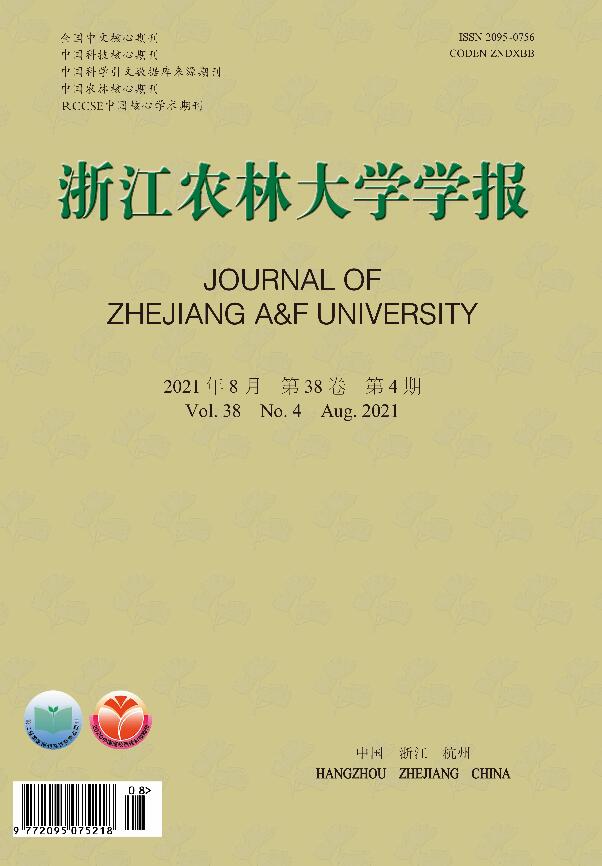





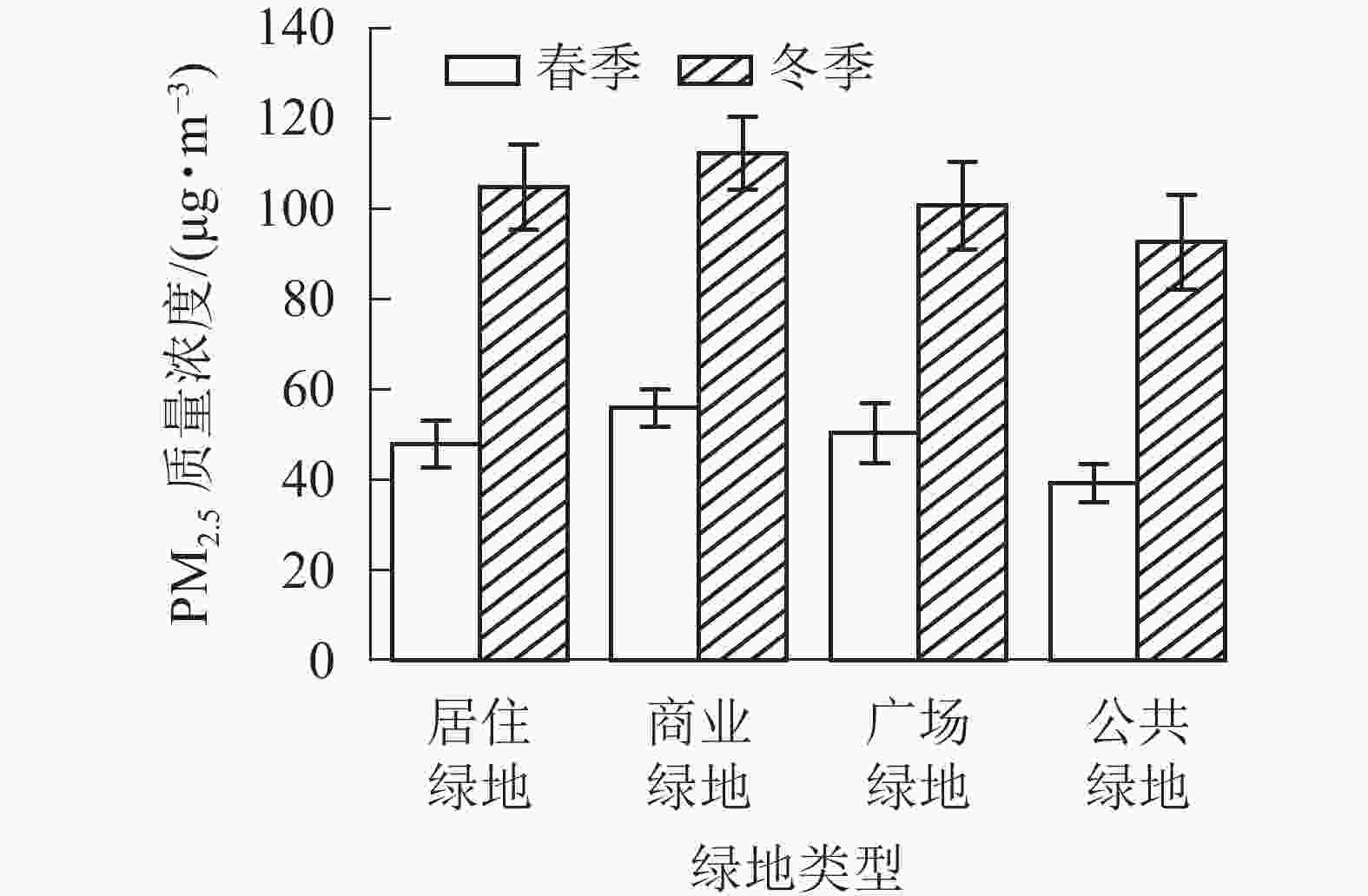
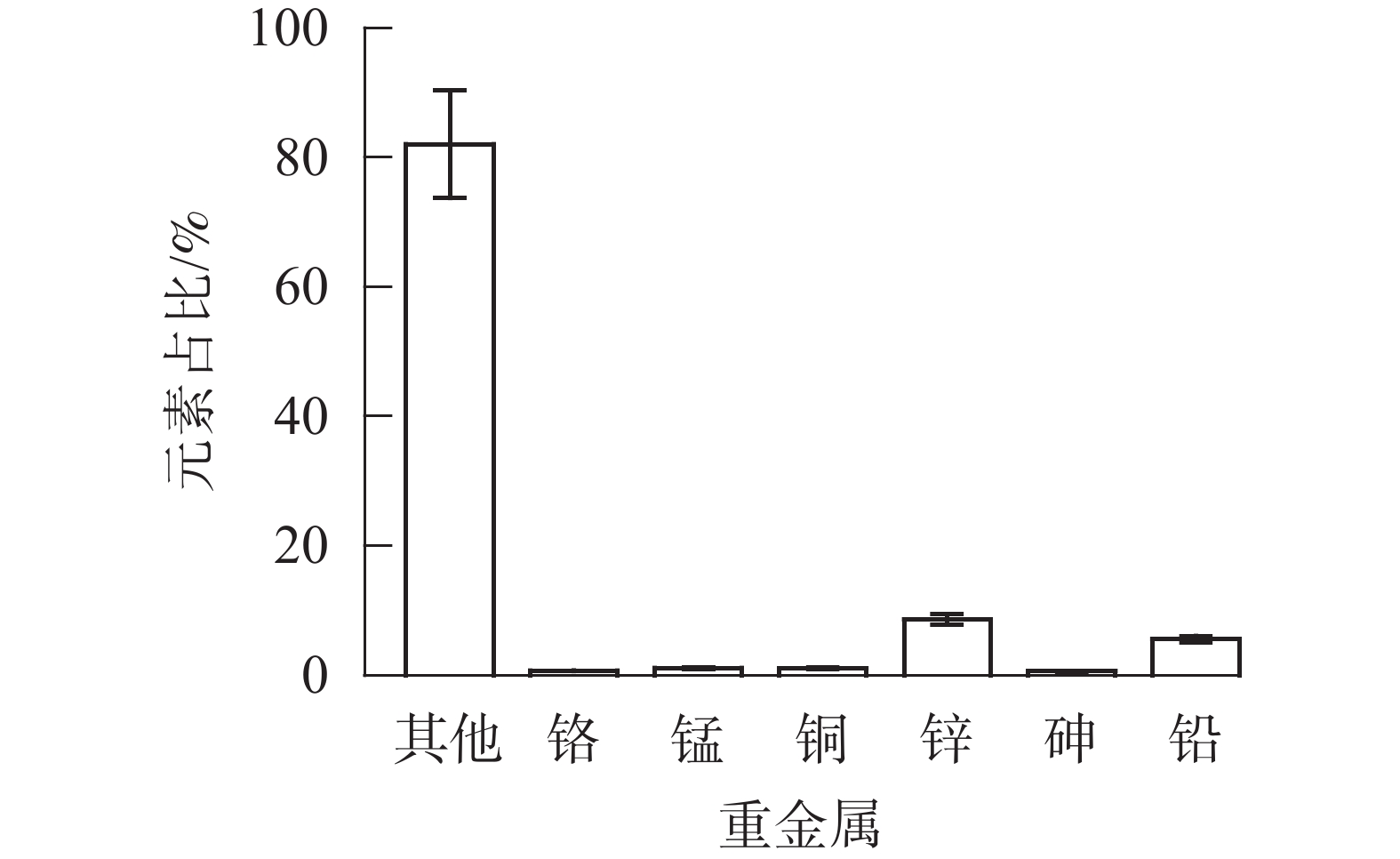
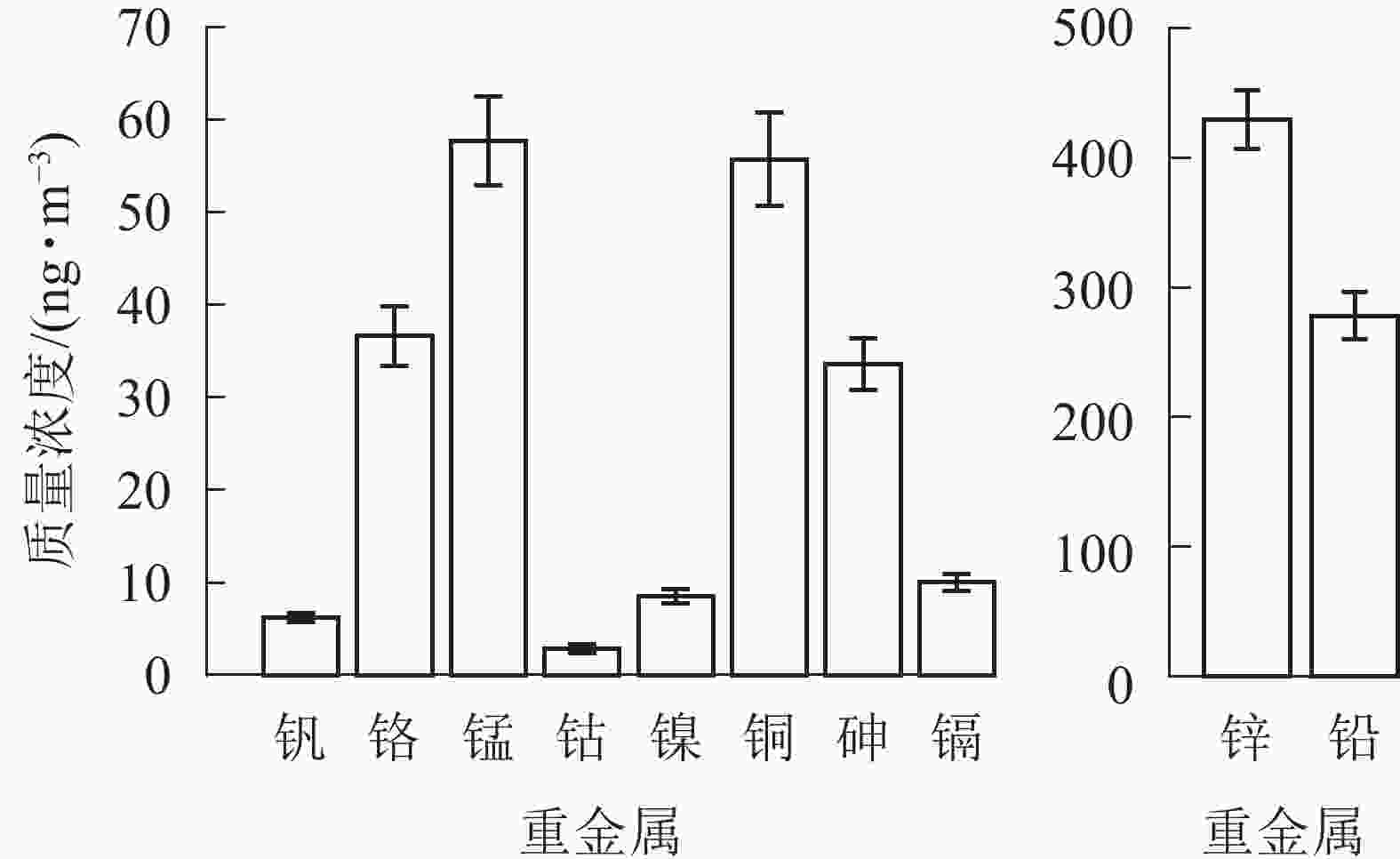
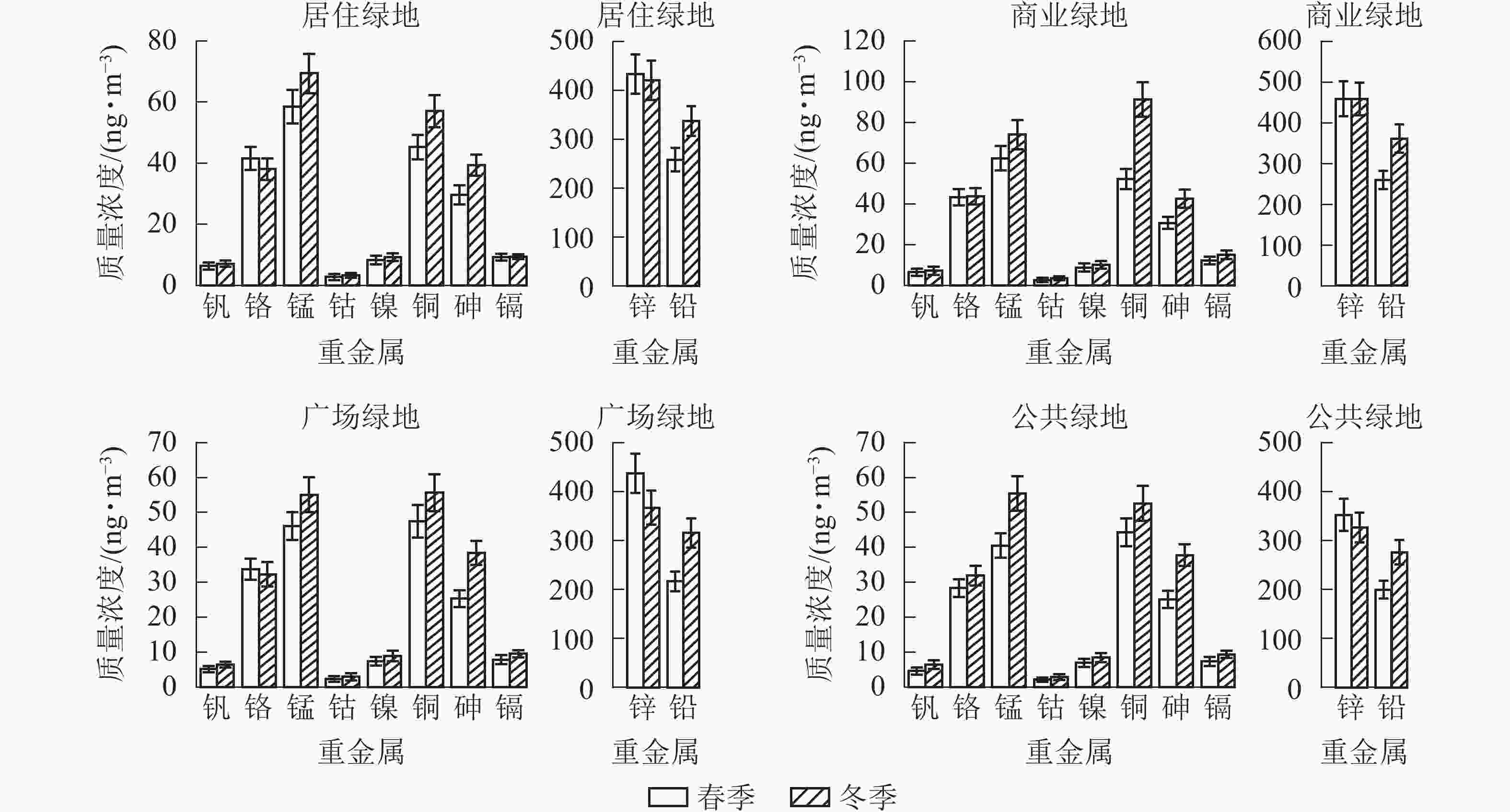
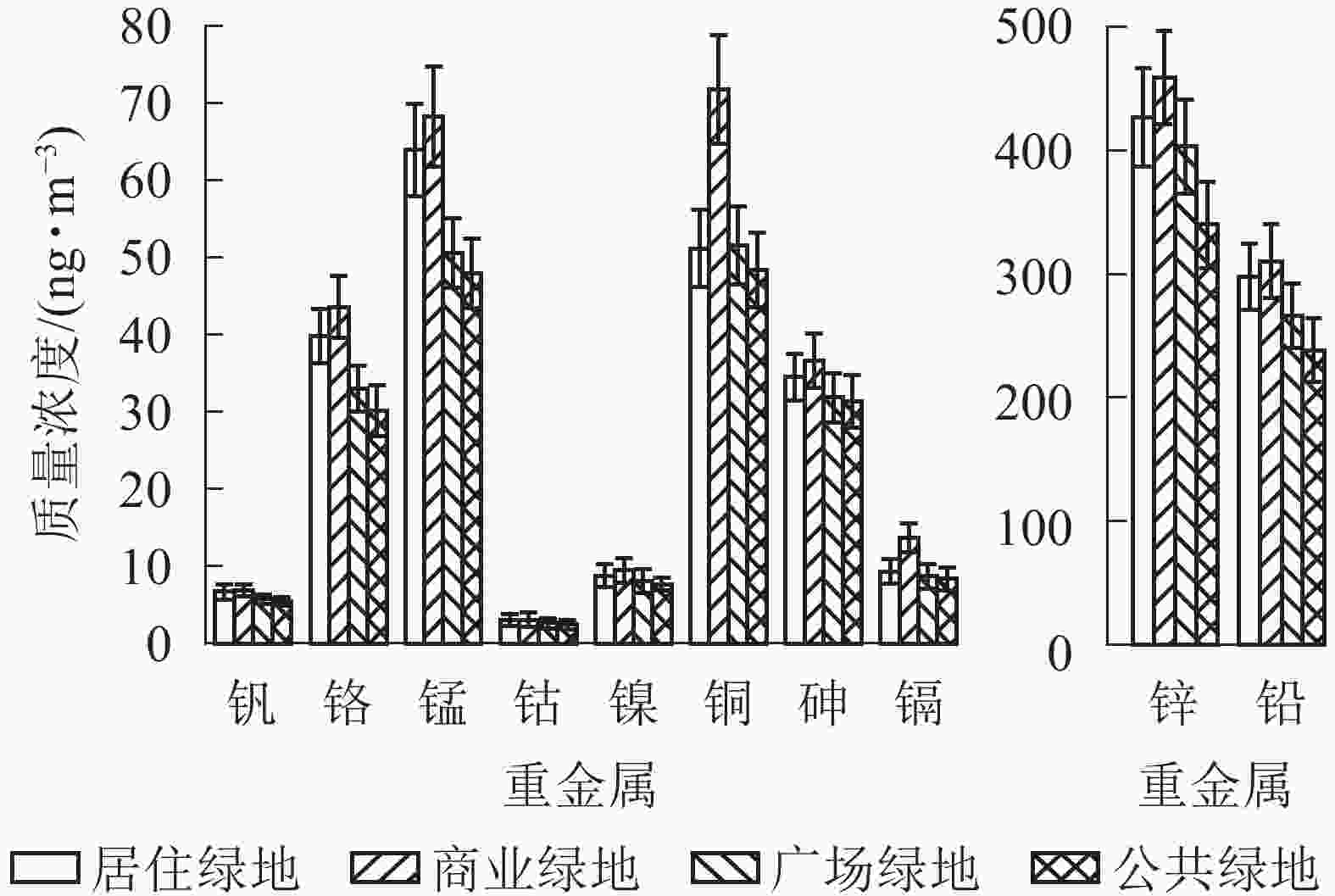
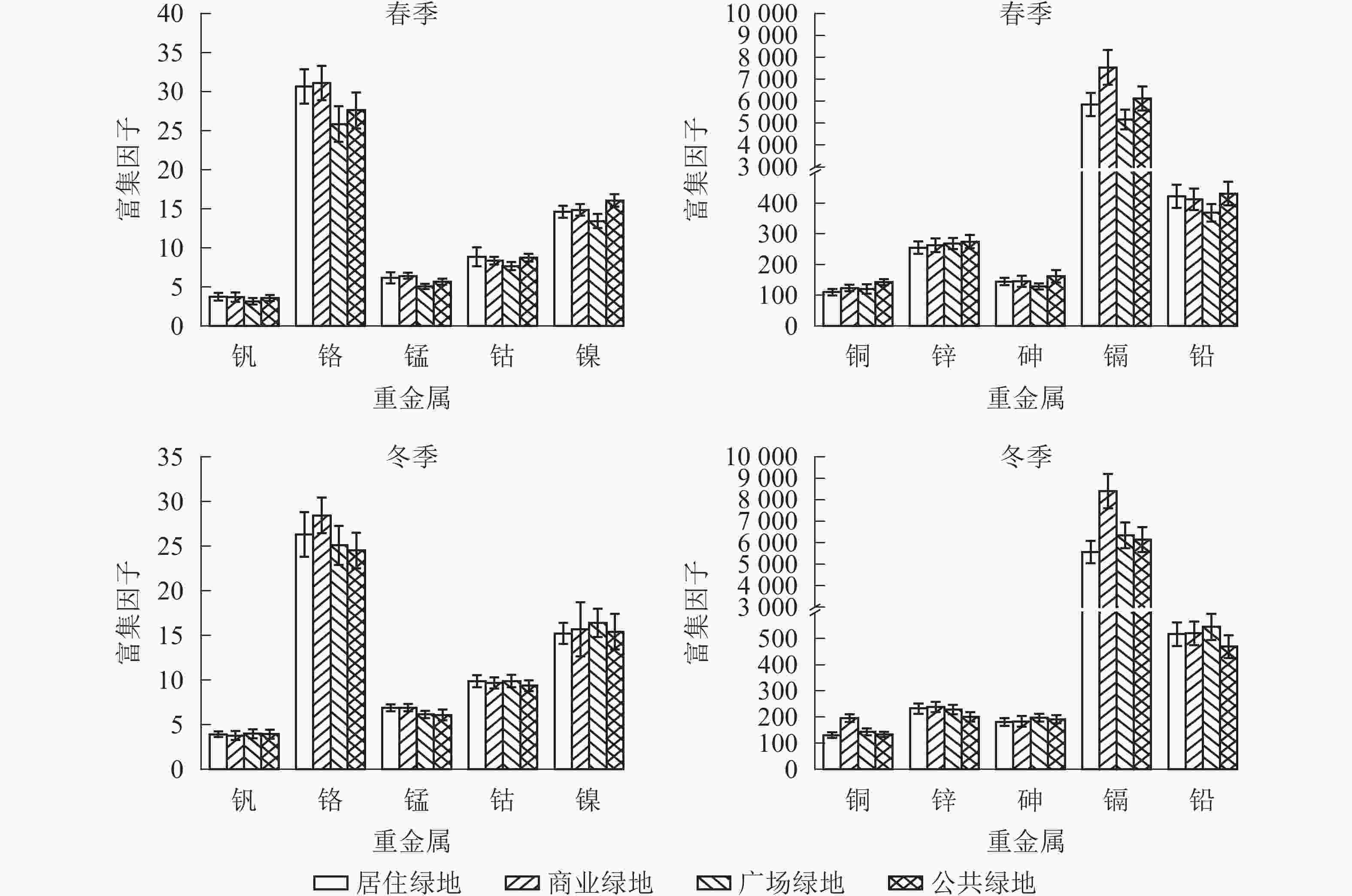
 DownLoad:
DownLoad:
